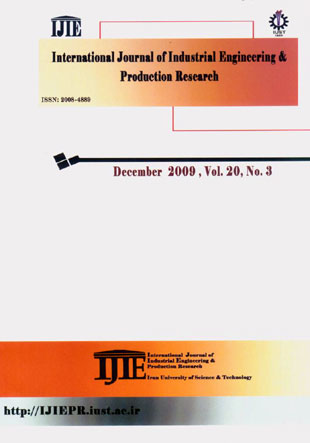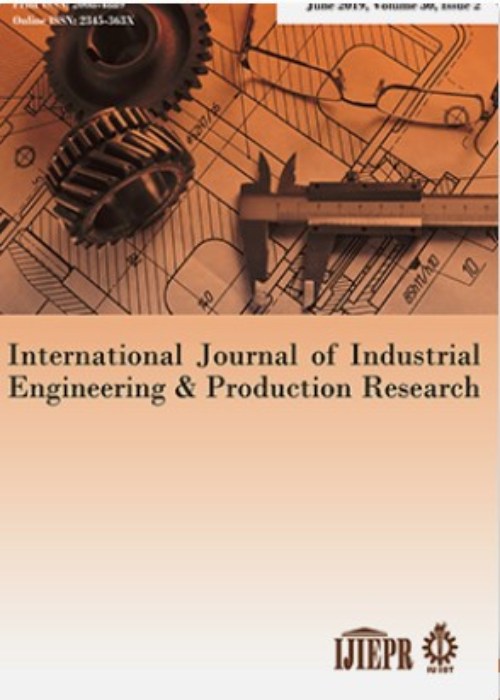فهرست مطالب

International Journal of Industrial Engineering and Productional Research
Volume:20 Issue: 3, Dec2009
- 56 صفحه،
- تاریخ انتشار: 1388/12/01
- تعداد عناوین: 6
-
-
Page 83Local bus network is the most popular transit mode and the only available transit mode in the majority of cities of the world. Increasing the utility of this mode which increases its share from urban trips is an important goal for city planners. Timetable setting as the second component of bus network design problem (network route design; timetable setting; vehicle assignment; crew assignment) have a great impact on total travel time of transit passengers. The total travel time would effect on transit utility and transit share of urban trips. One of the most important issues in timetable setting is the temporal coverage of service during the day. The coverage of demand is an objective for setting timetables which has not been well studied in the literature. In this paper a model is developed in order to maximize the temporal coverage of bus network. The model considers demand variation during the day as well as the stochastic nature of demand. A distribution function is used instead of a deterministic value for demand. The model is then implemented to an imaginary case.
-
Page 92The dynamic nature of projects and the fact that they are carried out in changing environments, justify the need for their periodic monitoring and control. Collection of information about the performance of projects at control points costs money. The corrective actions that may need to be taken to bring the project in line with the plan also costs money. On the other hand, penalties are usually imposed when due to “no monitoring” policies projects are delivered later than expected. Thence, this paper addresses two fundamental questions in this regard. First question concerns the optimal frequency of control during the life cycle of a project. The second question concerns the optimal timing of control points. Our solution methodology consists of a simulation-optimization model that optimizes the timing of control points using the attraction-repulsion mechanisms borrowed from the electromagnetism theory. A mathematical model is also used to optimally expedite the remaining part of the project when possible delays are to be compensated.
-
Page 99This paper is to develop a knowledge management (KM) model in some Iranian academic research centers (ARC) based on KM critical success factors. General KM critical success factors (CSF) were identified through literature review. Then the research procedure led to the identification of KM critical success factors in Iranian ARCs including 16 different factors. It was done through first stage survey by about 300 sample targets. Then, these 16 factors were surveyed separately again by experts through a Delphi panel. The experts suggested their practical solutions for exploiting the 16 factors in ARCs through a KM framework based on a KM cycle. This 2 years research has been done during 2006 to 2008.
-
Page 107This paper studies a maintenance policy for a system composed of two components, which are subject to continuous deterioration and consequently stochastic failure. The failure of each component results in the failure of the system. The components are inspected periodically and their deterioration degrees are monitored. The components can be maintained using different maintenance actions (repair or replacement) with different costs. Using stochastic regenerative properties of the system, a stochastic model is developed in order to analyze the deterioration process and a novel approach is presented that simultaneously determines the time between two successive inspection periods and the appropriate maintenance action for each of the components based on the observed degrees of deterioration. This approach considers different criteria like reliability and long-run expected cost of the system. A numerical example is provided in order to illustrate the implementation of the proposed approach.
-
Page 117We present an improved implementation of the Wagner-Whitin algorithm for economic lot-sizing problems based on the planning-horizon theorem and the Economic- Part-Period concept. The proposed method of this paper reduces the burden of the computations significantly in two different cases. We first assume there is no backlogging and inventory holding and set-up costs are fixed. The second model of this paper considers WWA when backlogging, inventory holding and set-up costs cannot be fixed. The preliminary results also indicate that the execution time for the proposed method is approximately linear in the number of periods in the planning-horizon.
-
Page 124Service Oriented Enterprises (SOEs) are subject to constant change and variation. In this paper, the changes are considered from an economic perspective based on service culture notion. Once a change is implemented, the costs of some member services may increase, whereas the costs of some other services may reduce. We construct a game theoretic model trying to capture the possible conflicting interests of different parties in a SOE. Three incentive mechanisms are applied to the model. The first incentive mechanism shares the utility equally among the services involved in the change; the second utility-sharing rule is based on the Nash’s bargaining solution, which accommodates the possible biased interdependencies inside the network; and the third rule, based on the Harsanyi’s modified Shapley value, takes into account the possible coalition formation among the network parties. Since the three rules are analytically solvable, the principles of utility sharing can be implemented, for instance, as ex-ante contracts.


